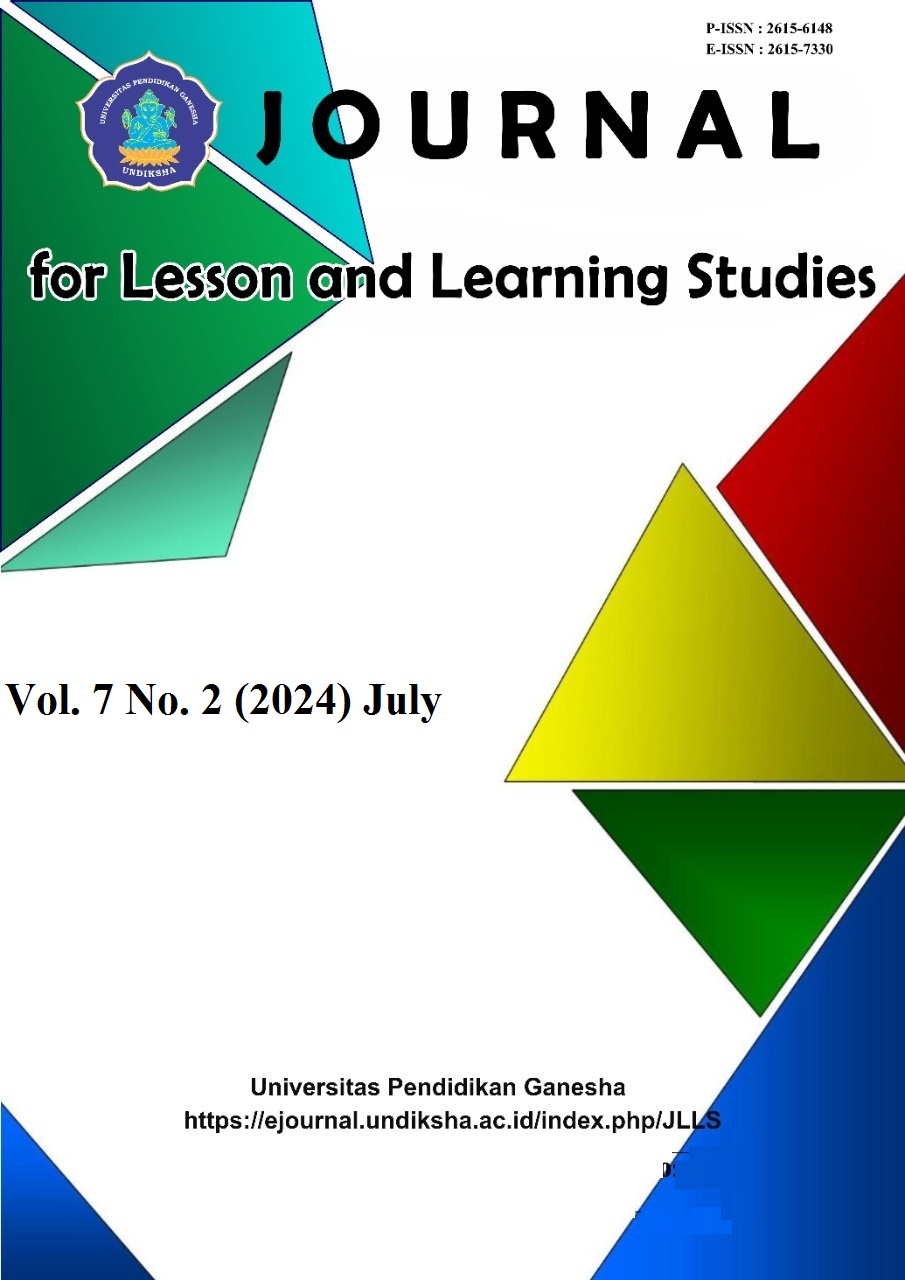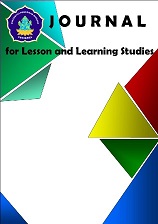Enhancing Massage Course Training in Sports Education through Validated and Practical Audio-Visual Learning Media
DOI:
https://doi.org/10.23887/jlls.v7i2.81126Kata Kunci:
Massage, Media, Audio VisualAbstrak
This study addresses issues in teaching massage techniques within sports education programs, particularly concerning students' inadequate understanding and skill development. To enhance learning outcomes, this research and development (R&D) study employed the ADDIE model, focusing on the creation and validation of video-based learning media specifically designed for massage courses. The research subjects included material and media experts as well as sports education students from Padang State University. Validation results indicated that the video content met high academic and design standards, achieving scores of 88.33% from material experts and 94.54% from media experts. Practicality tests with students yielded positive feedback, with scores of 85.9% for the small group and 85.2% for the large group, demonstrating the media's effectiveness and user-friendliness. These findings suggest that video-based learning media can significantly improve understanding and engagement in complex subjects. This approach offers flexibility and supports diverse learning styles, potentially enhancing educational outcomes and fostering a more interactive learning environment.
Referensi
Abuhassna, H., Al-Rahmi, W. M., Yahya, N., Zakaria, M. A. Z. M., Kosnin, A. B. M., & Darwish, M. (2020). Development of a New Model on Utilizing Online Learning Platforms to Improve Students’ Academic Achievements and Satisfaction. International Journal of Educational Technology in Higher Education, 17, 1–23. https://doi.org/10.1186/s41239-020-00216-z.
Afify, M. K. (2020). Effect of interactive video length within e-learning environments on cognitive load, cognitive achievement, and retention of learning. Turkish Online Journal of Distance Education, 21(4), 68–89. https://dergipark.org.tr/en/doi/10.17718/tojde.803360.
Afriza, D. (2022). Comparison of The Learning Outcomes of Junior High School Students Utilizing Audio-Visual and Chart Learning Media to Study Ecosystem. Journal of Science and Technological Education, 1(1), 48–57. https://meta.amiin.or.id/index.php/meta/article/view/4.
Alfita, F., Jumadi, Avita, D., & Azzam, A. (2024). TALIGITAR: Innovative Media in Increasing Elementary School Students’ Learning Interest. Journal for Lesson and Learning Studies, 7(1), 13–23. https://doi.org/10.23887/jlls.v7i1.70964.
Alnedral, Ihsan, N., Umar, Mario, D. T., Aldani, N., & Sari, D. P. (2023). Digital-Based e-Modules in Tarung Derajat Martial Arts Learning at Basic Level. International Journal of Human Movement and Sports Sciences, 11(2), 306–315. https://doi.org/10.13189/saj.2023.110207.
Armah, Z. (2021). Implementation of Audio-Visual Media Counseling on the Knowledge and Attitudes of Environmentally Lifestyles. International Journal of Multicultural and Multireligious Understanding (IJMMU), 8(11), 196–205. https://doi.org/10.18415/ijmmu.v8i11.3067.
Balakrishnan Nair, B. (2022). Endorsing gamification pedagogy as a helpful strategy to offset the COVID-19 induced disruptions in tourism education. Journal of Hospitality, Leisure, Sport and Tourism Education, 30(July 2021), 100362.1-9. https://doi.org/10.1016/j.jhlste.2021.100362.
Barman, M., & Jena, A. K. (2023). Effect of interactive video-based instruction on learning performance in relation to social skills of children with intellectual disability. International Journal of Developmental Disabilities, 69(5), 683–696. https://doi.org/10.1080/20473869.2021.2004535.
Borges Gomes, L. A., Alves da Cunha, R., Dias Lopes, A., Andrelino de Souza, F., Cruvinel Costa, F., & Vicente Andreoli, C. (2023). Landing Technique and Ankle-dorsiflexion Range of Motion are not Associated with the History of Lower Limb Injuries among Youth Basketball Athletes. International Journal of Sports Physical Therapy, 18(2), 358–367. https://doi.org/10.26603/001c.73033.
Cahyadi, R. A. H. (2019). Pengembangan Bahan Ajar Berbasis Addie Model. Halaqa: Islamic Education Journal, 3(1), 35–42. https://doi.org/10.21070/halaqa.v3i1.2124.
Daryanes, F., Darmadi, D., Fikri, K., Sayuti, I., Rusandi, M. A., & Situmorang, D. D. B. (2023). The Development of Articulate Storyline Interactive Learning Media Based on Case Methods to Train Students Problem-Solving Ability. Heliyon, 9(4). https://doi.org/10.1016/j.heliyon.2023.e15082.
Demircioglu, T., Karakus, M., & Ucar, S. (2022). Developing Students’ Critical Thinking Skills and Argumentation Abilities Through Augmented Reality–Based Argumentation Activities in Science Classes. In Science and Education (Vol. 32, Issue 4). Springer Netherlands. https://doi.org/10.1007/s11191-022-00369-5.
Djazilan, M. S., & Hariani, M. (2022). Implementation of E-Learning-Based Islamic Religious Education. Bulletin of Science, Technology and Society, 1(2), 14–21. https://inti.ejournalmeta.com/index.php/inti/article/view/12.
Faigenbaum, A. D., & Myer, G. D. (2010). Resistance training among young athletes: Safety, efficacy and injury prevention effects. British Journal of Sports Medicine, 44(1), 56–63. https://doi.org/10.1136/bjsm.2009.068098.
Fridayanti, Y., Irhasyuarna, Y., & Putri, R. F. (2022). Pengembangan Media Pembelajaran Audio-Visual Pada Materi Hidrosfer Untuk Mengukur Hasil Belajar Peserta Didik SMP/MTS. JUPEIS : Jurnal Pendidikan Dan Ilmu Sosial, 1(3), 49–63. https://doi.org/10.55784/jupeis.vol1.iss3.75.
Hite, R. L., Jones, M. G., Childers, G. M., Ennes, M., Chesnutt, K., Pereyra, M., & Cayton, E. (2019). Investigating Potential Relationships Between Adolescents’ Cognitive Development and Perceptions of Presence in 3-D, Haptic-Enabled, Virtual Reality Science Instruction. Journal of Science Education and Technology, 28(3), 265–284. https://doi.org/10.1007/s10956-018-9764-y.
Husain, R., Harefa, A. O., Cakranegara, P. A., Nugraha, M. S., & Hernaeny, U. (2022). The Effect of Teacher Professional Competence and Learning Facilities on Student Achievement. AL-ISHLAH: Jurnal Pendidikan, 14(2), 2489–2498. https://doi.org/10.35445/alishlah.v14i2.1060.
Insani, K., Welis, W., Bahtra, R., Putra, A. N., Ockta, Y., Hasan, H., & Orhan, B. E. (2024). the Impact of Training Methods and Endurance on Developing Basic Football Technical Skills in Extracurricular Football Programs. Community Practitioner, 21(5), 1103–1112. https://doi.org/10.5281/zenodo.11239182.
Jannah, M., & Sandika, F. A. (2023). Interactive Powerpoint Media on Thematic Learning in Primary School. Jurnal Edutech Undiksha, 6(2), 276–286. http://ejournal.ijshs.org/index.php/edu/article/view/805.
Jasiyah, R., Rumahlewang, E., Mundung, B. I., Sairdama, S. S., & Saputra, N. (2024). Learning Management System Difficulties during the Learning Process in Higher Education. Journal for Lesson and Learning Studies, 7(1), 1–12. https://doi.org/10.23887/jlls.v7i1.68665.
Jiang, S., & Ning, C. F. (2023). Interactive communication in the process of physical education: are social media contributing to the improvement of physical training performance. Universal Access in the Information Society, 22(4), 1315–1324. https://doi.org/10.1007/s10209-022-00911-w.
Khan, A., Khan, S., Zia-Ul-Islam, S., & Khan, M. (2017). Communication Skills of a Teacher and Its Role in the Development of the Students’ Academic Success. Journal of Education and Practice, 8(1), 18–21. https://eric.ed.gov/?id=EJ1131770.
Khumaedi, M., Widjanarko, D., Setiadi, R., & Setiyawan, A. (2021). Evaluating the impact of audio-visual media on learning outcomes of drawing orthographic projections. International Journal of Education and Practice, 9(3), 613–624. https://doi.org/10.18488/journal.61.2021.93.613.624.
Lange, C., & Costley, J. (2020). Improving online video lectures: learning challenges created by media. International Journal of Educational Technology in Higher Education, 17(1). https://doi.org/10.1186/s41239-020-00190-6.
Lanos, M. E. C., Ihsan, N., Okilanda, A., Handayani, W., Manullang, J. G., & Lestari, H. (2023). Effectiveness of Interactive Multimedia Supported Physical Education Using Jurus Tunggal Tangan Kosong in the New Normal Era. International Journal of Human Movement and Sports Sciences, 11(2), 261–267. https://doi.org/10.13189/saj.2023.110201.
Mackenbrock, J., & Kleinert, J. (2023). Motivational effects of digital media on students in physical education: a scoping review. Journal of Physical Education and Sport, 23(8), 2115–2126. https://doi.org/10.7752/jpes.2023.08243
Mahfud, A., Nurrochmah, S., & Amiq, F. (2022). The development of mobile learning based physical fitness learning media in grade x high school students in Pasuruan Regency. Journal of Science and Education (JSE), 3(2), 151–158. https://doi.org/10.56003/jse.v3i2.167.
Mentara, H., Sardiman, & Kandupi, A. D. (2022). Pengaruh Sport Massageterhadap Penurunan Denyut Nadi. Tadulako Journal Sport Sciences And Physical Education, 10(1), 57–64. https://doi.org/10.32529/bsej.v3i1.2373.
Montaner Sanchis, A., Gumbau Puchol, V., Villalba Ferrer, F., & Eleuterio Cerveró, G. (2022). Mobile learning in human anatomy: Application market study. Educacion Medica, 23(2). https://doi.org/10.1016/j.edumed.2022.100726.
Nolastname, M., Lindawati, A. S. L., Fernando, E., Deniswara, K., & Wahyuningtias, D. (2021). The Role of Information Technology and Communication Technology as Online Learning Media. ACM International Conference Proceeding Series, 25–29. https://doi.org/10.1145/3466029.3466051.
Ockta, Y., Umar, U., Komaini, A., Firdaus, K., Padli, P., & Masrun, M. (2024). Walk, run, jump and learn: Interactive multimedia for teaching locomotor skills in primary schools. Research and Development in Education (RaDEn), 4(1), 1–11. https://doi.org/10.22219/raden.v4i1.31831.
Pitnawati, Damrah, Handayani, S. G., Putra, A. N., Sasmitha, W., Nelson, S., Wulandari, I., Angelia, L., Ningsih, M. S., & Ockta, Y. (2023). Development of direct and indirect assistance approach using jigsaw method and android-based digital design method for gymnastic materials. Journal of Physical Education and Sport, 23(12), 3292–3298. https://doi.org/10.7752/jpes.2023.12376.
Pratama, K. R., Yamtinah, S., & Roemintoyo, R. (2023). Identifying the Utilization of ICT-Based Interactive Media in School during Pandemic Covid-19. Journal of Education Research and Evaluation, 7(1), 88–97. https://doi.org/10.23887/jere.v7i1.55173.
Puspitarini, Y. D., & Hanif, M. (2019). Using Learning Media to Increase Learning Motivation in Elementary School. Anatolian Journal of Education, 4(2), 53–60. https://eric.ed.gov/?id=ej1244451.
Putri, M. E., Yerizon, & Khaidir, C. (2021). Development of Problem-Based Learning (PBL) Instrument to Improve Mathematical Communication. Journal of Physics: Conference Series, 1742(1). https://doi.org/10.1088/1742-6596/1742/1/012023.
Radicchi, E., & Mozzachiodi, M. (2016). Social talent scouting: A new opportunity for the identification of football players? Physical Culture and Sport, Studies and Research, 70(1), 28–43. https://doi.org/10.1515/pcssr-2016-0012.
Raibowo, S., & Nopiyanto, Y. E. (2020). Evaluasi Pembelajaran Pendidikan Jasmani Olahraga & Kesehatan pada SMP Negeri Se-Kabupaten Mukomuko melalui Pendekatan Model Context, Input, Process & Product (CIPP). Jurnal Pendidikan Kesehatan Rekreasi, 6(2), 146–165. https://doi.org/10.5281/zenodo.3881891.
Sablić, M., Mirosavljević, A., & Škugor, A. (2021). Video-Based Learning (VBL)—Past, Present and Future: an Overview of the Research Published from 2008 to 2019. Technology, Knowledge and Learning, 26(4), 1061–1077. https://doi.org/10.1007/s10758-020-09455-5.
Safitri, R., Alnedral, A., Gusril, G., Wahyuri, A. S., & Ockta, Y. (2023). Pengaruh Model Pembelajaran Project Based Learning dan Problem Based Learning dengan Self Confidence Terhadap Hasil Belajar Atletik Lari Jarak Pendek. Gelanggang Olahraga: Jurnal Pendidikan Jasmani Dan Olahraga (JPJO), 7(1), 20–29. https://doi.org/10.31539/jpjo.v7i1.7292.
Safitri, R., Alnedral, Wahyuri, A. S., Gusril, Wahyuri, A. S., & Ockta, Y. (2024). The Impacts of the Project-Based Learning and Problem-Based Learning Models with Self- Confidence on Students ’ Learning Outcomes. IRJE (Indonesian Research Journal in Education), 8(1), 269–283. https://doi.org/10.22437/irje.v8i1.31480.
Salve, R., Kher, A., Chaudhary, R., Swarnakar, K., Gaikawad, S., Uke, P., & Lakhkar, B. (2022). Health education interventional programme and its impact on adolescent students. Sri Lanka Journal of Child Health, 51(1), 69–74. https://doi.org/10.4038/sljch.v51i1.9998.
Sattar, M. U., Palaniappan, S., Lokman, A., Shah, N., Khalid, U., & Hasan, R. (2020). Motivating medical students using virtual reality based education. International Journal of Emerging Technologies in Learning, 15(2), 160–174. https://doi.org/10.3991/ijet.v15i02.11394.
Sudarko, R. A., Hariono, A., Tirtawirya, D., Tomoliyus, & Nugroho, H. (2023). Evaluation of Disability Sports Training Program at the National Paralympic Committee (NPC) Special Region of Yogyakarta. International Journal of Human Movement and Sports Sciences, 11(4), 746–752. https://doi.org/10.13189/saj.2023.110407.
Sukmawati, F., Santosa, E. B., Rejekiningsih, T., Suharno, & Qodr, T. S. (2022). Virtual Reality as a Media for Learn Animal Diversity for Students. Jurnal Edutech Undiksha, 10(2), 290–301. https://doi.org/10.23887/jeu.v10i2.50557.
Umar, Ockta, Y., & Mardesia, P. (2023). A Correlational Study: Pedagogical and professional competence of physical education teachers in relation to the implementation of the Merdeka curriculum. Journal of Physical Education and Sport, 23(12), 3325–3331. https://doi.org/10.7752/jpes.2023.12380.
Utami, I. G. A. L. P. (2015). Teacher Certification Program in Indonesia: Problems and Recommendation for the Betterment of the Program. International Journal of English and Education, 4(2), 471–481. http://ijee.org/assets/docs/Lokita_-_April_15.4202426.pdf.
Viet, N. M., & Hanh, N. D. (2021). Assessment Perspectives on the Sports Values and Role of the Higher Education Institution Head for Sports Development in the School. Higher Education Studies, 11(4), 1. https://doi.org/10.5539/hes.v11n4p1.
Yusuf, A., Munif, Hasyim, M., Anan, A., & Hadi, M. N. (2021). Media Information Communication and Technology (ICT) Development Strategy in Education Learning. Journal of Physics: Conference Series, 1783(1). https://doi.org/10.1088/1742-6596/1783/1/012127.
Unduhan
Diterbitkan
Cara Mengutip
Terbitan
Bagian
Lisensi
Hak Cipta (c) 2024 Arif Selfa Selvani, Eddy Marheni, Syahrial Bakhtiar, Wilda welis, Eko Purnomo

Artikel ini berlisensiCreative Commons Attribution-ShareAlike 4.0 International License.
Authors who publish with the Journal for Lesson and Learning Studies agree to the following terms:
- Authors retain copyright and grant the journal the right of first publication with the work simultaneously licensed under a Creative Commons Attribution License (CC BY-SA 4.0) that allows others to share the work with an acknowledgment of the work's authorship and initial publication in this journal.
- Authors are able to enter into separate, additional contractual arrangements for the non-exclusive distribution of the journal's published version of the work (e.g., post it to an institutional repository or publish it in a book), with an acknowledgment of its initial publication in this journal.
- Authors are permitted and encouraged to post their work online (e.g., in institutional repositories or on their website) prior to and during the submission process, as it can lead to productive exchanges, as well as earlier and greater citation of published work. (See The Effect of Open Access)





